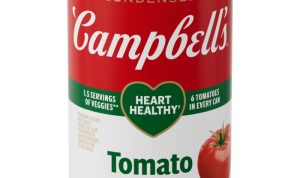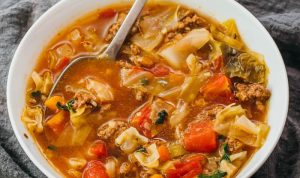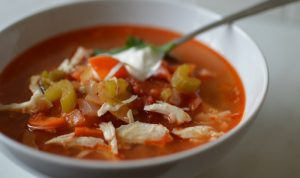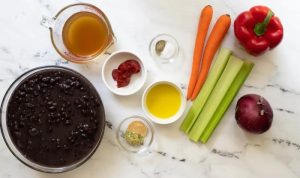Recipe Variations: Exploring Diverse Vegetable Beef Soup Profiles

Source: tasteofhome.com
Vegetable beef soup recipe best – Vegetable beef soup is a comforting classic, but its versatility allows for endless creative exploration. Three distinct variations showcase the diverse flavor profiles achievable by emphasizing different vegetable types.
| Recipe Name | Key Vegetables | Broth Type | Special Ingredients |
|---|---|---|---|
| Hearty Root Vegetable Beef Soup | Carrots, parsnips, potatoes, turnips, celery root | Beef broth | Smoked paprika, thyme, a splash of red wine |
| Vibrant Leafy Green Beef Soup | Kale, spinach, chard, escarole, green beans | Chicken broth (for lighter flavor) | Lemon zest, garlic, a touch of nutmeg |
| Mixed Vegetable Beef Soup | Carrots, celery, onions, green beans, corn, peas, potatoes | Vegetable broth (for vegetarian option) | Bay leaf, fresh parsley, a pinch of dried oregano |
Flavor Enhancement Tips:
- Root Vegetable: Roast the root vegetables before adding them to the soup for a deeper, sweeter flavor. A touch of maple syrup enhances the natural sweetness.
- Leafy Green: Wilt the greens slightly before adding them to the soup to prevent them from becoming overly watery. A squeeze of lemon juice brightens the flavor.
- Mixed Vegetable: Use a combination of fresh and frozen vegetables for optimal texture and flavor. A sprinkle of fresh herbs at the end adds a burst of freshness.
Nutritional Benefits:
Root vegetable variations are rich in beta-carotene (carrots, parsnips), vitamin C (turnips), and fiber (potatoes). Leafy green variations offer high levels of vitamins A, K, and C, along with iron and folate. Mixed vegetable variations provide a balanced profile of vitamins and minerals, depending on the specific vegetables included. The beef provides protein and iron. Choosing vegetable broth creates a vegetarian option lower in saturated fat.
Ingredient Selection and Preparation: Elevating the Soup’s Foundation
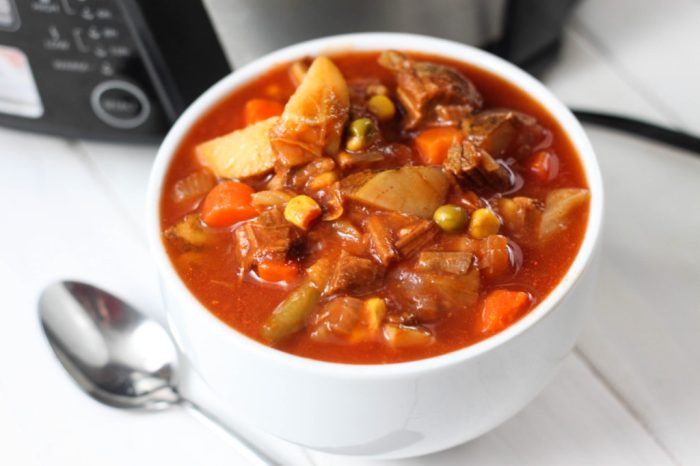
Source: farmwifecooks.com
Careful ingredient selection and preparation are crucial for a superior vegetable beef soup. The quality of ingredients directly impacts the final flavor and texture.
Best Beef Cuts:
Beef shanks, chuck roast, or short ribs are ideal choices for vegetable beef soup. These cuts are tougher but contain more collagen, resulting in a richer, more flavorful broth after slow cooking. Their connective tissues break down during the cooking process, adding body and depth to the soup.
Vegetable Preparation:
- Wash all vegetables thoroughly.
- Peel and chop root vegetables into roughly 1-inch pieces. Dice onions and celery into smaller pieces.
- For leafy greens, remove tough stems and chop into bite-sized pieces.
- Consider pre-cooking some vegetables, such as carrots and potatoes, to ensure even cooking and prevent them from becoming mushy in the soup.
Broth Comparison:
- Beef Broth: Provides a deep, savory flavor that complements the beef and vegetables.
- Chicken Broth: Offers a lighter, more delicate flavor, suitable for those who prefer a less intense beefy taste.
- Vegetable Broth: Creates a vegetarian-friendly option with a slightly sweeter, earthier flavor.
Cooking Methods and Techniques: Mastering the Art of Vegetable Beef Soup
Various cooking methods yield different results. Choosing the right method depends on time constraints and desired texture.
Cooking Method Comparison:
- Slow Cooking: Yields the most tender beef and deeply flavorful broth. Requires longer cooking time (6-8 hours or overnight).
- Stovetop Cooking: Offers quicker cooking time (2-3 hours) but may require more attention to prevent burning. Results in a slightly less tender beef but still flavorful.
- Pressure Cooking: The fastest method (1-1.5 hours), resulting in tender beef and a flavorful broth. Requires a pressure cooker.
Creating a Rich Broth from Scratch:
- Brown the beef in a large pot over medium-high heat.
- Add aromatics (onions, carrots, celery) and sauté until softened.
- Pour in cold water, scraping up any browned bits from the bottom of the pot.
- Add herbs and spices (bay leaf, thyme, peppercorns).
- Bring to a boil, then reduce heat and simmer for at least 2 hours, or until the beef is tender.
- Strain the broth, removing the beef and vegetables.
Ideal Consistency and Texture:
The ideal vegetable beef soup has a rich, flavorful broth that is not overly thick or watery. The vegetables should be tender but not mushy, maintaining their shape and color. The beef should be easily shredded or cut into bite-sized pieces.
Serving and Presentation: Elevating the Dining Experience
Creative serving suggestions and thoughtful presentation transform a simple soup into a memorable culinary experience.
Serving Suggestions:
- Serve in rustic bowls with a dollop of sour cream or crème fraîche, and a sprinkle of fresh herbs.
- Garnish with crusty bread for dipping, or serve with a side of grilled cheese sandwiches.
- Offer a variety of toppings such as shredded cheese, chopped green onions, or a drizzle of olive oil.
Visual Presentation:
Use attractive bowls that complement the soup’s color. Garnish thoughtfully with fresh herbs, a swirl of cream, or a sprinkle of paprika. Set the table with a simple yet elegant tablecloth and napkins.
Leftover Transformations:
- Use leftover soup as a base for hearty stews or casseroles.
- Thicken the soup and serve it over noodles or rice.
- Freeze leftover soup in individual portions for quick and easy meals.
Troubleshooting Common Issues: Perfecting Your Vegetable Beef Soup
Addressing common issues ensures a consistently delicious result. Proactive solutions prevent disappointments.
| Problem | Solution |
|---|---|
| Overly salty broth | Add a peeled potato or a few slices of apple to absorb excess salt. Dilute with additional water or broth. |
| Mushy vegetables | Reduce cooking time or pre-cook vegetables to a slightly firmer consistency. Avoid over-stirring the soup. |
| Bland flavor | Add more herbs, spices, or a splash of acid (lemon juice, vinegar) to enhance the flavor profile. Consider adding a flavorful ingredient such as Worcestershire sauce or soy sauce (use sparingly). |
Dietary Adjustments:
For low-sodium diets, use low-sodium broth and reduce the amount of added salt. For vegetarian options, replace beef with hearty vegetables like mushrooms or lentils and use vegetable broth. Adjust spices and herbs to accommodate individual preferences.
General Inquiries: Vegetable Beef Soup Recipe Best
Can I freeze leftover vegetable beef soup?
Yes, vegetable beef soup freezes beautifully. Allow it to cool completely before storing in airtight containers for up to 3 months.
What can I substitute for beef broth?
You can substitute chicken broth or vegetable broth, but the flavor will be slightly different. Beef broth provides the richest and most traditional flavor.
How can I make my soup thicker?
To thicken your soup, you can add a cornstarch slurry (mix cornstarch with cold water), or simmer it uncovered for a longer time to reduce the liquid.
The best vegetable beef soup recipe often starts with a rich, slow-simmered broth. But sometimes, a comforting change is needed, and that’s where the creamy indulgence of an ultimate potato soup recipe comes in. After enjoying that hearty alternative, you’ll appreciate the depth of flavor even more when you return to your perfectly crafted vegetable beef soup, a testament to culinary exploration and the simple joys of home cooking.
Can I use different vegetables?
Absolutely! Feel free to experiment with your favorite vegetables. Consider adding potatoes, carrots, corn, peas, or green beans.


